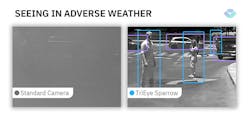Denso to Evaluate TriEye’s CMOS-Based SWIR Camera for Vehicle Imaging
Israeli startup TriEye Ltd., a Tel-Aviv based company whose short-wave infrared (SWIR) sensing technology enhances visibility in adverse weather and night-time conditions, officially revealed Sparrow, which the company maintains is the world's first CMOS-based SWIR camera. Note that SWIR is typically defined as light in the 0.9- to 1.7-μm wavelength range, but it’s also considered as wavelengths from 0.7 to 2.5 μm (Fig. 1).
Among the companies collaborating with TriEye and evaluating the Sparrow is global automotive supplier Denso, in addition to the leading sports car manufacturer Porsche. Denso is a $47.6 billion global mobility supplier that develops advanced technology and components for nearly every vehicle make and model on the road today.
The evaluation of Sparrow by Denso, Porsche, and other TriEye customers is demonstrating its ability to deliver critical image data under a wide range of imaging scenarios. This is made possible by leveraging the unique physical properties of the SWIR spectrum. The sensor is particularly effective in low-visibility conditions, such as identifying black ice, dark-clothed pedestrians, and cyclists (Fig. 2), and under low-light or other common low-visibility conditions. TriEye’s SWIR camera can be integrated as a standard visible camera and reuse existing visible image AI algorithms, which saves the effort of recollecting and annotating millions of miles.
Indium-gallium-arsenide (InGaAs)-based SWIR cameras have been around for decades, and found applications in science, aerospace, and defense industries. However, they haven’t been suitable for mass-market applications due to their high costs and large form factor. TriEye technology is the result of a decade of nanophotonics research and enables the fabrication of a CMOS-based HD SWIR sensor at scale, which is small size and 1000X lower cost than current technology.
The company has already delivered samples of the Sparrow to its non-automotive customers in addition to the ongoing evaluation by TriEye's automotive customers. This will allow them to take advantage of TriEye's SWIR capabilities to see beyond the visible and solve complex industry challenges.
About the Author

Bill Schweber
Contributing Editor
Bill Schweber is an electronics engineer who has written three textbooks on electronic communications systems, as well as hundreds of technical articles, opinion columns, and product features. In past roles, he worked as a technical website manager for multiple topic-specific sites for EE Times, as well as both the Executive Editor and Analog Editor at EDN.
At Analog Devices Inc., Bill was in marketing communications (public relations). As a result, he has been on both sides of the technical PR function, presenting company products, stories, and messages to the media and also as the recipient of these.
Prior to the MarCom role at Analog, Bill was associate editor of their respected technical journal and worked in their product marketing and applications engineering groups. Before those roles, he was at Instron Corp., doing hands-on analog- and power-circuit design and systems integration for materials-testing machine controls.
Bill has an MSEE (Univ. of Mass) and BSEE (Columbia Univ.), is a Registered Professional Engineer, and holds an Advanced Class amateur radio license. He has also planned, written, and presented online courses on a variety of engineering topics, including MOSFET basics, ADC selection, and driving LEDs.


